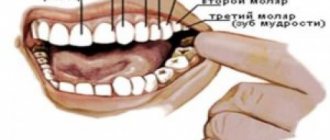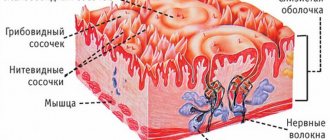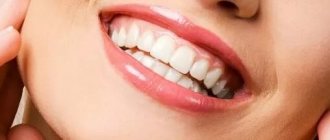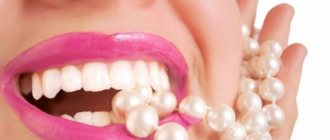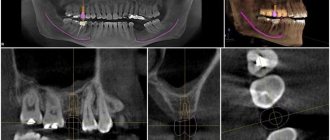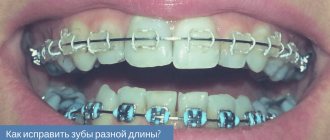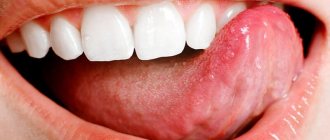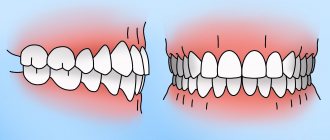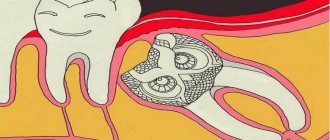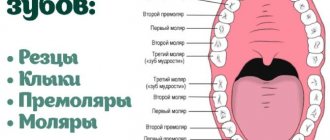Fangs, or dantes kanini, are teeth that are cone-shaped and located in two on the upper and lower jaws. The canines of the upper jaw are always larger than the lower ones. They occupy the third place from the midline and have a spear-shaped crown. They serve to hold food and then tear it apart. The lingual surface has a concave appearance and tubercle, while the labial surface, on the contrary, is more convex. In fangs, the roots have a slightly laterally compressed shape, but at the same time they are the longest and strongest.
How many teeth does an adult have?
An adult human may have between 28 and 32 teeth . Any amount in this range is considered normal today. For our ancestors, the norm was larger: their jaws contained 44 chewing outgrowths necessary for grinding coarse and tough food. Perhaps due to evolution, the number of teeth of a healthy adult will be reduced to 26, since the diet consists of thermally processed foods that do not require thorough chewing.
The difference of 1-4 molars in an adult is determined by the presence of wisdom teeth. They are formed in adulthood by the age of 30. However, their absence is not considered a deviation from the norm, since they are “optional”, which in most cases of eruption have to be removed.
Teeth are divided into several types:
In dentistry, the definition is done in a different way. In addition to the distinction between incisors, canines, premolars and molars, the structure of the jaw matters. Both jaws have the same number of incisors, canines and molars, and each jaw can be conditionally divided into 2 parts, which are “mirror”, so doctors name the teeth by numbers, indicating the row and side for greater accuracy. For example, three at the bottom left. The numbering comes from the front incisors. The chewing teeth are called premolars and molars, depending on their size and sequence. The structure of each type of tooth is not significant, but it is different.
Evolution has endowed humans with teeth with a certain shape, since they serve different purposes. The incisors, of which there are 4 on each jaw, have a wide, pointed edge, which should separate the piece from a large portion. The fangs have a cone-shaped shape with a narrow and sharp edge, since their function is to tear off, for which they need to be well strengthened. Chewing teeth, which are the most abundant in the mouth, are necessary for grinding food to facilitate the work of the gastrointestinal tract.
How many teeth do children have?
The basis for the formation of the dentition appears when the child is still in the womb, so sometimes children are born with erupted lower incisors. In most cases, they begin to appear at 6 months. Full formation of the jaw row ends by 3 years. And in total there are 20 milk teeth in the child’s mouth. The only thing missing is chewing teeth, which are permanent and do not change, like fangs and incisors. Their formation in the gums begins only at the age of 6, when milk teeth begin to fall out and are replaced by permanent ones.
Since there were no premolars initially, they do not have a clearly designated place; they appear on the vacant area of the gum. Since the jaw grows along with the child, the free space increases not only with the loss of another tooth. And the full shift ends only by 12-14 years.
The change period is very important: at this moment problems with bite may arise. Most often this happens when a new tooth erupts before the baby tooth falls out. As with any developmental anomalies, you should contact your dentist to clarify the situation.
How is extension carried out - methods
Today, dental clinics use various methods of canine restoration for this purpose. The choice of method will depend on the initial condition of the teeth, the wishes of the patient and the individual recommendations of the doctor.
Extension using the direct method
This is the most gentle method, which involves modifying the shape of the tooth directly in the patient’s mouth. It is carried out by layer-by-layer application of composite material. When the mold is ready, the tooth is ground and polished. In this case, the parameters are selected taking into account the individual characteristics of the dentofacial apparatus, and the entire procedure takes about 1.5 hours.
The photo shows direct canine extensions
Installation of veneers or lumineers
Veneers are the thinnest overlays on teeth that are fixed on their front side, allowing you to hide defects, yellowness, small chips and cracks and at the same time give the element the desired shape. But before installing such overlays, it is necessary to grind off the enamel somewhat to improve adhesion. Next, the doctor applies an adhesive composition to the prepared surface and fixes the veneer. A more advanced and expensive option is lumineers - these are ultra-thin plates, the fixation of which usually does not require preliminary preparation.
You can grow your teeth with veneers
Installation of artificial crowns
The most radical method is crown prosthetics. The procedure is quite labor-intensive and usually requires extensive preparation of living hard tissue. In this case, artificial crowns are created taking into account the anatomical features of the patient’s jaw system and can be installed on ground teeth, stump inlays or pins.
First, the specialist makes an impression, which is then sent to a dental laboratory, where an artificial fang is created based on it. It can be made of metal ceramics or zirconium dioxide. The latter option is considered more preferable today, since, along with high aesthetics, it is characterized by increased wear resistance and strength.
The issue can also be resolved using crowns
Basic principles of dental care
Part of the condition of teeth depends on heredity, but proper care means much more. You need to start teaching children about oral hygiene as soon as their first incisors appear. This will not only help the remaining teeth erupt, but will also create a habit of caring for your oral cavity. Parents should also lead by example.
You need to brush your teeth 2 times a day and floss after each meal. It is necessary to choose the right brush with moderately stiff bristles and a not too large head. For people who have problems in the oral cavity, it is recommended to have several pastes, since medicinal products improve only one component: the condition of the gums, the whiteness of the enamel, the absence of caries.
Healthy and strong teeth are the result of not only daily brushing, but also proper nutrition. Often, children who do not get enough vitamins have teeth that begin to grow later, and there is a greater risk of getting a malocclusion. The diet, including that of an adult, should include vegetables and fruits with a hard shell, which helps to naturally cleanse and strengthen the enamel. In some regions, there is a noticeable lack of minerals, so you should take additional vitamin and mineral complexes. The formation of enamel is affected by a lack or excess of fluoride and calcium.
Daily hygiene and proper nutrition are two main tenets. However, do not forget about regular visits to the dentist, who will help prevent dental problems, and also, when identifying the first signs of damage, will prescribe remedies to eliminate the disease.
Sometimes bad habits are to blame for poor oral health. Smoking, a love of coffee or black tea, and constant consumption of carbonated drinks lead to thinning of the enamel and yellow plaque, which can be removed with dental procedures. Enamel is also negatively affected by food that is too hot or cold, mechanical damage, or attempts to whiten the enamel with hydrogen peroxide or soda. Pastes with a whitening effect should also not be used daily.
What is a dental formula
A dental formula or diagram is a brief description of the dental structure of the human dentition using numbers and Latin letters. The letters are abbreviations from the Latin names of teeth accepted in medicine:
- I – these are dentes incisivi or incisors.
- C is for dentes canini or fangs.
- P stands for dentes premolars or premolars.
- M stands for dentes molars or molars.
The alphanumeric dental formula is common in many countries, including America, which is why it is sometimes called American. After the letters in the formula there is always a digital fraction, where the numerator indicates the number of teeth on the upper jaw, and the denominator on the lower jaw.
The dental formula of a healthy adult with a normal bite and 32 teeth looks like this:
This formula indicates that on each human jaw there is:
- 2 pairs of incisors;
- 1 pair of fangs;
- 2 pairs of premolars;
- 3 pairs of molars.
Dental formula in the absence of some teeth
It is not difficult to correctly number dental units with a healthy dentofacial apparatus; it is much more difficult to indicate the location of the teeth if a person does not have any molars, incisors, canines or premolars. In this case, the dentist indicates the number 0 opposite a certain group of teeth, rather than shifting the number series.
If the patient has any anomalies in the development of the dentofacial apparatus, for example, teething in the wrong place (hyperdontia, polydontia), the dentist prescribes an individual formula. In addition to numerical designations, the doctor generates a detailed report on the structure of a person’s dentition.
Children's adult dental problems
Emerging molars may already have dental problems, and parents should be prepared for them.
No molars
All the average periods for changing teeth have passed, but the permanent ones are still not showing. In this case, dairy products behave differently: they fall out or continue to remain in place. When consulting a dentist, a survey X-ray is taken, which clearly shows the skull with the developing molars. The reasons for growth retardation may be a hereditary predisposition (and the picture will show this) or edentia - the absence of the rudiments of adult teeth due to a violation of their formation in the prenatal period. Death due to inflammation is also possible. In such cases, prosthetics are recommended for both the child and the future adult.
My tooth hurts
Immediately upon eruption, the tooth enamel has not yet reached a normal level of mineralization. This period is dangerous due to the high risk of adult caries in children. When affected by caries, especially if deep destruction occurs, pulpitis develops, and if treatment is not timely, periodontitis develops. In such cases, the baby constantly experiences toothache, the temperature may rise, and general malaise is observed. The best way to relieve your child of toothache is a visit to the clinic. Delay leads to the spread of caries and the loss of an already permanent tooth.
If a child has had problems with caries on baby teeth, as a preventive measure, fissure sealing can be done - closing the natural deep pockets on the molars with composite materials. This procedure prevents the accumulation of food debris and plaque in the pockets, and therefore reduces the risk of infection.
Grow unevenly
If the molars erupt before the baby teeth fall out, their normal growth and alignment are disrupted. If the molar grows behind the milk tooth, this leads to malocclusion and the need for orthodontic treatment. During consultation with a dentist, the baby tooth is removed to give a chance to correct the crooked primary tooth. It is not recommended to loosen a tooth on your own (let alone pull it out).
Causes of malocclusion in a child, as well as methods of correction. How to help your child during teething, read this article.
Permanent teeth fall out
If children's molars fall out, this may indicate that the child has health problems. This situation can be caused by both oral diseases (gum inflammation, pulpitis, caries) and general diseases (diabetes mellitus, rickets, systemic connective tissue diseases). The loss of a permanent dentition tooth is a serious problem, since the restoration of the lost tooth will require serious attention. This primarily concerns the teeth of the anterior group. In order for the development of the maxillofacial system to proceed normally, the child needs a temporary prosthesis, which must be replaced as the jaw grows. And only when it is completely formed, you can begin permanent prosthetics.
Injuries to molars
Children are very mobile, so there is always a risk of various injuries. Since teeth continue to mature for several years after eruption, the risk of damage to them from a fall or impact is quite high. Doctors often see young patients with a broken tooth or a crack after a minor injury. For minor damage, correction is carried out and volume is increased with composite materials.
Many parents are interested in the question: do molars change again and whether children can grow new teeth if they lose old ones. Cases of repeated replacement of dentition in dental practice are rare as an exception. So you need to take care of all your teeth – both permanent and baby teeth, no matter how much effort it takes. Look at the photo - molars in children, as well as the stages of changing baby teeth to permanent ones - in the video.
Gingivitis in children - treatment and prevention
Gingivitis is an unpleasant and fairly common disease that often occurs in children and adolescents and requires proper treatment. Advanced gingivitis can lead to tooth loss.
Teeth are one of the most important organs of the human body. They are the first to take on the responsibility of processing food, sending the mass already prepared for digestion into the esophagus. Good jaw condition is one of the indicators of good health of the body as a whole. But the number of instruments in the mouth is no less important than their quality. It is traditionally believed that a modern adult has 32 fully formed teeth in his mouth. However, many can only find 28 in their mouth.
All this raises several questions for us. How many teeth does a person have today? Does he need all of them and perform a useful function? What is the future direction of development of the human jaw? And why doesn’t everyone get their so-called “wisdom teeth”?
Description, structure, functions, name and location of human teeth
It is not without reason that human teeth have different shapes, structures and sizes. Each tooth performs certain functions, and its purpose is, one way or another, reflected in the name:
- The incisors are the front teeth that fall into the smile zone. They are quite sharp as their function is to tear or cut food, hence the name. Normally, every person has lateral and central (larger) incisors.
- Canines are cone-shaped teeth that can be used to tear and hold food. They are located immediately behind the incisors.
- Premolars are the small back molars located behind the canine teeth.
- Molars are the back teeth necessary for mechanical processing of food. Wisdom teeth refer specifically to molars.
The listed types of teeth are also found in animals. But in the process of their evolution, some dental units were slightly modified:
- elephants' upper incisors became tusks;
- Poisonous snakes have poison in their fangs.
Many animals have front teeth similar to human ones, but since they are called differently, they cannot always be identified with the usual incisors and canines.
The structure of human teeth
Human teeth consist of a crown and a root part. The first is located above the level of the gum, the second is inside it. The top of the crown is covered with enamel, the strongest tissue in the body. It protects the inner layer of the tooth – dentin – from external influences. Under the dentin there is a hollow chamber with nerves and blood vessels - the pulp.
Despite its strength, enamel is vulnerable to bacteria. If left untreated, caries can affect the dentin and pulp. When the pulp chamber, which contains nerve fibers, is damaged, pulpitis develops, accompanied by acute throbbing pain. If the infection spreads to the root of the tooth, it is highly likely that it will have to be removed.
The basis of the lower part of the tooth is the root canals, which also contain arteries, veins and nerve fibers. Through the apical foramen, all of these structures are connected to the main neurovascular bundle.
The lower part of the tooth is covered with dentin and cement, which is attached to the periodontium using collagen fibers. The roots of teeth are hidden in the alveoli - depressions in the jaw bone.
On what basis are teeth numbered according to different classification systems?
In addition to the Latin names of teeth, digital designations are used in dentistry. The numbering of teeth is based on the order in which they erupt. It starts from the front incisors (from the middle of the jaw) and runs to the left and right of them.
There are several generally accepted systems for numbering human teeth.
Universal system
Most often, dentists name teeth not by the Latin alphabet, but according to their location in the oral cavity (ordinal number). Moreover, using not Roman, but familiar Arabic numerals.
Names of teeth according to the universal classification system:
- two central incisors are located at number 1 and are called ones;
- the second incisors are numbered 2;
- the fangs are called triplets;
- chewing teeth or premolars are called fours and fives;
- molars are called sixes, sevens and eights.
According to the universal system of classification of dental units, the jaw is divided into 4 segments:
- top left;
- top right;
- bottom right:
- bottom left.
The further name indicates not only the serial number, but also the location of the dental unit in the human oral cavity.
The universal dental numbering system is the most popular and frequently used. It is used by dental therapists and surgeons in various countries.
The picture shows a diagram of the designation of teeth in the oral cavity of an adult according to the universal numbering system:
Is it worth attaching importance to signs?
There are many superstitions that modern people inherited from their ancestors. Today, some people do not attach importance to signs. Other people, on the contrary, take them seriously. Attitude towards superstitions is everyone’s personal choice. But you need to monitor the health of your teeth and oral cavity from childhood.
It is necessary to visit the dentist regularly, treat diseases in a timely manner, and observe the rules of hygiene. These activities will help you maintain good health and avoid many problems.
Found a violation? Report content
Alternative names for human teeth
In addition to the official names, there are also alternative names for human teeth. They are not written in dental records, but have long been used in informal communication, since these teeth in people are located or grow in certain places or at certain times.
Eye teeth
The upper canines are called eye teeth because of their close location to the branches of the facial nerve. When they become inflamed, the pain radiates to the eye area and upper face. How close the incisive canals and the dental nerve are located to each other is shown in the figure:
Wisdom tooth
The wisdom tooth is the posterior third molar. He was called “wise” because he grows up in adulthood - when a person has already gained wisdom (by about 20 years).
Strange "seedlings"
As you know, not only children, but also adults lose teeth.
Some superstitious people do not leave lost body parts in the dentist's office, but bury them in pots of violets or geraniums. According to the sign, this will bring good luck and wealth. By the way, it is still customary for gypsies to bury extracted wisdom teeth in the cemetery. Representatives of this people believe that such a ritual brings material well-being.
How buns with sour cream helped the future husband of Natalya Krachkovskaya win her
The “California” strain of coronavirus frightened American scientists
Bill Gates and calcium carbonate are to blame: why do bloggers burn with snow?
Correct names of baby teeth
In Latin, baby teeth in a child are called the same as permanent teeth in an adult. But children do not have all the dental units characteristic of older people. Milk teeth are divided into:
- central incisors;
- lateral incisors;
- fangs;
- first and second molars.
There are different names for teeth, but it is better to focus on Latin terms and serial numbers. In this way, you can identify teeth even without serious knowledge of dentistry.
Fangs are a sign of anger
For any modern mother, the absence of such teeth in a baby is a reason to visit a dentist. But in some African and Asian countries, fangs are a sign of anger.
If the baby's teeth erupt first, the baby and his mother are kicked out of the village so as not to bring trouble to the rest of the inhabitants of the settlement. In some tribes, it is still customary to knock out the fangs of young men so that they behave prudently, do not show aggression, and sorcerers from enemy tribes cannot turn them into animals.
If a neighbor flooded his dacha: the Supreme Court explained how to protect your property
Sunken ships and other beautiful photos of the winners of the underwater competition
New maintenance rules postponed: what Russians need to be prepared for from March 1
How many teeth should an adult normally have?
If you have never had problems with the oral cavity, you may find it difficult to answer the question of exactly how many teeth an adult grows. It turns out that normally there can be from 28 to 32, since not everyone grows wisdom teeth.
Permanent teeth begin to replace baby teeth at the age of 6 to 12 years, but in dentistry the dentition of 16-year-old adolescents is considered to be finally formed. However, during this period, almost no one yet has wisdom teeth (third molars or “eights”), but their rudiments should already be formed. However, they may not appear at all, and this happens for many reasons:
- heredity and genetic characteristics;
- the influence of evolution on the development of human teeth;
- nutritional habits and more.
It would be useful to point out that in the process of evolution, the number of teeth in the mouth of people changed; initially there were 44 of them. This is due to the fact that our distant ancestors ate hard, unprocessed meat of predatory animals, so their chewing teeth were more developed, and in the process chewing involved the entire jaw.
Over time, softer foods became the main food of man, and the jaws gradually became smaller. This has led to the fact that there is no longer always room for “eights”, so some wisdom teeth do not appear at all, and for many they begin to grow incorrectly, becoming the culprits of various problems and diseases.
Growth finally stops by the age of 25, so if the figure eights still haven’t come out, you should visit a dentist to rule out a developmental anomaly. He will conduct an examination to make sure that there is no hidden threat to teeth under number seven in the form of improperly growing neighbors.
Teeth are a bony organ that does not have the ability to repair itself. In a lifetime, teeth are replaced once - from baby teeth to molars. Without a doubt, it is important to keep them healthy for as long as possible.
Other interesting signs
Many Russian children heard from their parents that baby teeth should be “given to the mouse.” This is done to ensure that the permanent ones grow strong and healthy. American and European children put their lost tooth under their pillow. They believed that at night the fairy would leave a coin in his place.
According to the superstition, if an adult’s tooth cracks and falls out, trouble awaits the person. In such a situation, superstitious people prefer not to tempt fate. And hold off on serious decisions, plans, events.
If a tooth was knocked out as a result of a fight, the victim, according to the sign, will experience pleasant surprises and positive emotions.
If a person spits through his teeth (especially out the window), he incurs losses and illnesses. It is better to get rid of this unpleasant habit so as not to tempt fate.
A chipped piece from a tooth was considered an unfavorable omen.
It promises problems in the family, conflicts with loved ones or friends.
If a person gets caught in the rain for the first time in a year and hears thunder, he needs to find a stone on the road. And “bite” him. Such a ritual attracts well-being.
To avoid toothaches, according to superstition, you need to take off your shoes first from your left foot and then from your right foot.
If the baby does not develop teeth for a long time, you should cut the kitchen towel with a knife.
Structure of permanent teeth
An adult tooth consists of the following parts:
- The root is a process with which the tooth is securely attached to the alveolar tissue. The roots vary depending on the load on the tooth - the greater it is, the more developed the root system; The molars have the largest branched roots.
- The neck is the space between the root and the crown, located just below the edge of the enamel.
- The crown is a jaw socket in the alveolus. The surface part of the crown performs a chewing function. The crown is covered with enamel on top, which prevents pathogens from penetrating into the inside of the tooth.
- The pulp is the inner part, it makes up the dental canals and the pulp chamber, it is surrounded by dentin, which in turn provides support for the enamel.
Types of teeth
So, a healthy adult may have from 28 to 32 dental units in the oral cavity, each of which has its own purpose. You can find out what kind of teeth they are, what they are called, when they should grow and change to permanent ones, and what their functions are by studying the table below.
| Teeth | Description |
| Incisors | Incisors are teeth included in the smile zone; they are located in the center of the dentition above and below. Each person normally has four incisors on the upper jaw and the same number on the lower jaw. Their function is to capture and bite food. The time of eruption of primary incisors is from the age of 6 months, then they are replaced by permanent ones at the age of 5 years. |
| Fangs | The canines are located in the dentition next to the incisors. There are 4 of them, two on top and two on bottom. The main function is to deal with particularly hard pieces of food. Primary fangs appear when the child reaches one and a half years of age. Permanent fangs appear at age 9. |
| Premolars | Premolars or small molars are located next to the fangs, under two on each side on the upper and lower jaws, in total there are 8 of these teeth (we recommend reading: removal of the upper 8th tooth). Their function is to chop food into smaller pieces. Molars appear when a child reaches 10 years of age or older. |
| Molars | The number of molars is similar to the number of premolars; they perform a similar function - chewing food. |
| Third molars | The last teeth in the dentition, located in the most inaccessible places, are the third molars, popularly called wisdom teeth. They do not appear in children and adolescents; the main period of teething is from 18 to 25 years. For a large number of people, wisdom teeth do not grow back at all, and if they begin to erupt, they often cause pain and suffering for the person, as well as various dental problems, such as orthodontic problems. |
Signs of molar growth
- How to determine whether your baby will soon have molars? The imminent eruption of molars is indicated by:
- Increasing spaces between teeth in primary dentition. The loose position is explained by the growth of the jaw.
- Temporary teeth become loose because their roots gradually dissolve and cannot be securely attached to the jaw tissues.
- If a baby tooth falls out, this indicates the eruption of a permanent one – it is the temporary one that is being pushed out.
- Swelling and redness may appear on the gum where the tooth appears, and in rare cases, a cyst with clear liquid may appear.
Pain in the gum area, increased body temperature, and poor health do not accompany the eruption of molars. These signs may indicate the addition of an infection with reduced immunity, other dental and general diseases. If these signs appear, the child must be examined.
Anomalies in the number of teeth
There are many cases in dentistry where the number of dental units differs from the norm. Some or even all of the teeth may be missing from the jaw, or premature death may occur. As a rule, this process does not occur by itself and is the result of a disease suffered by the mother during pregnancy or by the baby in the first years of life. As a result, a person will have fewer teeth than expected.
Parents of young children often worry that baby teeth do not appear on time. In most cases, this is not a cause for concern; delayed or, conversely, early appearance of teeth does not indicate pathology and occurs in approximately 40% of all children. This feature is influenced by many factors, including the type of feeding.
As for permanent teeth, their health and timing of eruption are affected by dental diseases suffered during the formation of the dentition, including inflammatory processes near the roots of baby teeth. A purulent focus at the root can not only be responsible for delaying the growth of a molar, but also cause its death, then a permanent tooth will not appear in this place at all.
Another anomaly is the so-called supernumerary teeth. It happens that a person has extra canines and premolars; in this case, a patient at a dental clinic will have not 32, but 34 or even 36 teeth. In this situation, the doctor may advise removing excess growths. An extremely rare anomaly occurs when a person has one extra tooth in his mouth. This feature occurs in only 3% of the world's population.
Pregnancy and tooth loss
For many years, the birth of girls was considered an unpleasant event. But mothers and fathers were very happy about the birth of boys. After all, male children played the role of breadwinners of the family. The expectant mother carefully monitored all the signs that, according to popular belief, indicated the birth of a boy. One of these characteristic signs was considered to be poor dental condition during pregnancy. People believed that the son was “taking” them away from his mother. Experts say that this sign has no relation to reality. And it does not at all indicate that the future baby is male.
When do molars start to fall out?
The older a person gets, the fewer of his teeth remain in his mouth; over time, they have to be replaced with implants or dentures. The timing of the loss of the first teeth depends on many factors: first of all, heredity, and then compliance with the rules of oral hygiene, the presence of bad habits, especially smoking.
Some people may lose their first tooth at the age of 19, while others at 40 can boast of a full set of teeth. After 60 years, the vast majority of people no longer have one false tooth. By the age of 70, the enamel and crown are almost completely worn out, leaving only the roots and neck of the teeth.
